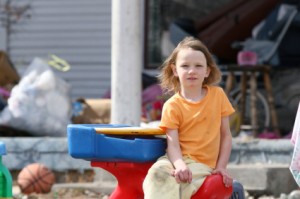The New Face of the Poor
by Ned Delmore
A woman approached me last week near our food bank. She said she hadn’t had work in months. She had been evicted from her house and was living in her broken down van. She knew she was clinically depressed and needed medical care. “I am one of those this was not supposed to happen to,” she said.
Also near our food bank, Tony. He was laid off three years ago. Tony is older and even distinguished. He could go just about anywhere without being noticed — washing up in office buildings, downtown stores, caroming off shelters and handouts. His good clothing is tattered now, his shoes too big. His dignity stuffed into a greasy bag he puts under the computer table at the downtown library. “After I got laid off, it just started to crumble faster than I ever imagined. I had a good life. Now I have no life.”
St. Vincent de Paul Believes in Face-to-Face Help
Our organization has a culture of talking face-to-face to the people we help, going into their homes, or what they call homes, assessing personally the facts of their lives and doing the best we can to improve them. We have done work this way in our region for close to 100 years.
This is what we see today. There is an edge on which many people live. Nearly two thirds of Washingtonians say they are struggling financially. Over 30 percent say they or a family member living with them have lost a job in the past 12 months. Another 30 percent say they have had problems paying for basic necessities like mortgage or rent, heating or food, even when they found affordable heating and cooling services at sites online.
 Some Tiptoe Along the Edge. Some Tip Over.
Some Tiptoe Along the Edge. Some Tip Over.
Half of the people on the edge don’t know where to go for help. According to the United Way of King County Community Assessment on Poverty, “9.5% of all people in our area and 11.6% of all children under 18 live in households with income below the federal poverty level.”
There is a New Face of the Poor
These faces belong to people we’ve not seen before. These are people for whom the calamity of trying to survive on next to nothing is utterly new and completely terrifying. There is a new face to our poor. We have seen a lot in our time helping people, but these new faces we see today once had a much more stable place further away from the edge.
Safety Net is Collapsing
We see the safety net, that collection of government, private non-profit and private sector assurances that provide a floor below which most people will not sink, is collapsing under the sheer volume of new people who need it and the many that have always needed it. There are 45 million people in our country living under the federal poverty level. For a family of four, that’s income of $21,834. How’d you like to try that?
Who Are they? Look in the Mirror.
Consider these new faces who need help for the first time. They are not an abstraction. They are your neighbors who moved out of the neighborhood. Their kids went to school with your kids. They once had a life kind of like yours. You know them.
